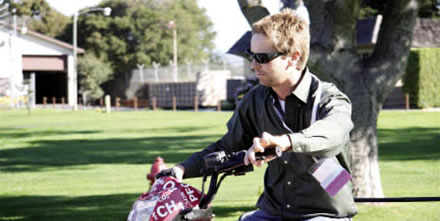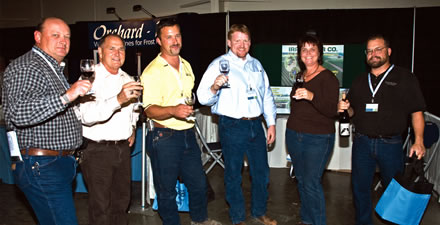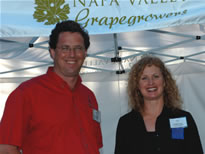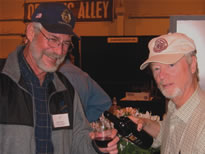
Growing & Winemaking
by Andy Starr
How to Prepare for the Next Disaster
There is little to add to the reporting about the firestorm that struck Mendocino, Napa and Sonoma wine country Oct. 8, 2017. It was unlike any other disaster to hit California.

Viewpoint
by Mary Loftness and Paul Wagner
What DtC Wine Sales Can Learn From Cruise Lines and Casinos
Given the importance of direct-to-consumer (DtC) sales in the wine industry, one might assume we have found the holy grail of customer relationship management. But compared to other hospitality industries such as cruise lines and casino gaming, we fall far short of best practices.

Growing & Winemaking
by Andy Starr
Start Planning Equipment Purchases Now
January in the winery. Harvest is in the rearview mirror, and wines are aging or getting ready for bottling. You had some time over the holidays to get reacquainted with your family and resume a normal sleep schedule.

Practical Winery & Vineyard
by Robert Smiley, Ph.D., and Nicholas Simmons
Industry Leaders Optimistic About Premium Wines
Millennials, whose baby boomer parents were the first generation of premium wine drinkers in the United States, are consuming more and higher value wines, driven by a thirst for quality, new experiences and information-sharing, according to wine industry leaders surveyed by the University of California, Davis.

Viewpoint
by Clark Smith
Selecting a Machine for Reverse Osmosis
Reverse osmosis machine sales are suddenly going crazy—up an order of magnitude from past years. Three decades after the introduction of reverse osmosis (RO), wineries are now prosperous enough to afford their own machines, and they are at last getting hip to the technology’s many quality-enhancing powers.

Viewpoint
by Pam Strayer
The Organic Opportunity: Will the U.S. Wine Industry Miss Out?
Every day, it seems the world is trending more and more toward organics. Sales of organic food are skyrocketing. England’s Prince Charles announced that’s he’s joining a new initiative to keep more of the world’s carbon in soils through organic farming techniques.

Growing & Winemaking
by Andrew Starr
Warming to New Tartrate Stabilization Methods
Tartrate stabilization, often called cold stabilization, is a wine treatment for the cosmetic benefit of avoiding tartrate crystal formation. Intellectually you know you don’t really need to do it, but you do it anyway. So the priority is to get it done while minimizing both the risk of degrading wine quality and cost.

Growing & Winemaking
by Fritz Westover
Top Seven Mistakes New Grapegrowers Make
I have worked with many vineyard startups during the past decade and evaluated prospective vineyard sites for countless soon-to-be grapegrowers east of the Rocky Mountains. New growers often start growing grapes while working other jobs or after a previous career—frequently one not related to agriculture.

Editor's Letter
by Jim Gordon
The Winemaking Process From Planting to Packaging
THE MAIN HEADLINE ON THE COVER of this issue is “Work Smarter in 2016.” We don’t mean to imply that you weren’t working smart in 2015, but with all the substantive new research and newly applied practices out there, you’re not yet done with your education.

Editor's Letter
by Jim Gordon
A New Look for the New Year
THIS ISSUE CELEBRATES A NEW YEAR of winemaking and the 96th birthday of Wines & Vines with an updated graphic design. So in addition to filling 164 pages with great articles about everything from rainstorms to drought to the Unified Wine & Grape Symposium, the issue introduces a new logo, type fonts and other improvements to keep our pages up to date.

Viewpoint
by Dennis Cakebread
Vintners Declare DtC Victory
Editor’s Note: The Coalition for Free Trade (CFT), established by vintners in 1995 as a nonprofit organization seeking judicial relief from laws prohibiting direct-to-consumer (DtC) shipments, announced Nov. 24 that it had ended all activities after achieving significant victories for wineries and wine lovers alike.
Think back to the 1980s and 1990s.

Editor's Letter
by Jim Gordon
Economic Picture Bright for Wineries
This issue begins Wines & Vines’ 95th year of publishing. It also marks the 15th year that we’ve produced a special edition for the Unified Wine & Grape Symposium, which takes place Jan. 28-30 in Sacramento, Calif.

Inquiring Winemaker
by Tim Patterson
Winemakers Rely on Living Equipment
What’s the most important piece of equipment in any winery?
Most of the gear buzz in the past few years has been about the nexus of sorting, destemming and (barely if at all) crushing: The quest for perfect, squeaky clean, absolutely intact berries at the start of fermentation. The choice of cooperages and toast levels in a barrel program can make or break a wine. Membranes do magical things. Flash Détente may save the world.
Of course, none of these gizmos come close to the most critical machinery in the cellar: the winemaker’s taste buds and his or her olfactory bulb. The reason wine is made by people and not computers or 3D printers is that some human has to taste and sniff the stuff all the way along the line and make dozens of decisions based on the mental readouts from these tiny little organs. It’s the place where art meets science in winemaking.
READ MORE »SEE EARLIER EDITIONS OF THIS COLUMN »
Grounded Grapegrowing
by Glenn McGourty
A Tale of Two Watersheds
Farming in California is becoming increasingly complicated as growers in our populous state are held responsible for the wellbeing of public trust resources that are on their property: air, water, fish and wildlife. Agriculture is estimated to use 80%-85% of the available water in our state to irrigate about 10 million acres of farmland.
The most common conveyances of water in our state are naturally flowing rivers. Rivers serve many purposes including water for towns and cities, farms and wildlife. Managing to satisfy all of these needs is a challenge. There are few rivers left that flow naturally unimpeded, the result of many dams that have been constructed during the past 100-plus years. Since much of California exists under drought conditions for many months of the year, storing water when it rains makes great sense. Problems arise when these impoundments impact the natural hydrology of a region (movement of water and sediment through the rivers) and prevent fish or other wildlife from their former habitat. How water is apportioned for different uses creates much controversy, and balancing the needs of natural systems, agriculture and urban use is a never-ending task.
What is a watershed?
READ MORE »SEE EARLIER EDITIONS OF THIS COLUMN »
Editor's Letter
by Jim Gordon
The To-Do List for 2012
With the new year comes a chance to improve yourself, your winery and your vineyard. Let’s leave the “yourself” part to other magazines like Oprah and Men’s Health, and focus on the other two. I think the wine industry now lives in a world quite different from that of 2007, when the wine business was firing on all eight cylinders.READ MORE »SEE EARLIER EDITIONS OF THIS COLUMN »
Inquiring Winemaker
by Tim Patterson
Costs and Benefits of Additives
READ MORE »SEE EARLIER EDITIONS OF THIS COLUMN »
Vineyard View
by Cliff Ohmart
Does Big Mean Unsustainable?
READ MORE »SEE EARLIER EDITIONS OF THIS COLUMN »
Editor's Letter
by Jim Gordon
DtC Sales Up, Teen Drinking Down
The news in December leading up to press time for this issue carried very positive stories for wineries: An important segment of wine sales is up while teen drinking is down. Is there a connection?
Direct-to-consumer (DtC) shipments from U.S.READ MORE »SEE EARLIER EDITIONS OF THIS COLUMN »
Inquiring Winemaker
by Tim Patterson
Is Barrel TCA the New Cork Taint?
Is contamination of French oak barrels by TCA the new cork taint? Or is this just old news wrapped in fresh press releases? That question may be the biggest 2010 year-end controversy in the wine trade, overshadowing old reliables like whether screwcaps make for clean wines or reduced wines, or whether genetically modified yeast is a swell idea or a non-starter.READ MORE »SEE EARLIER EDITIONS OF THIS COLUMN »
Vineyard View
by Cliff Ohmart
Is IPM Dead?
The inspiration for this column came from a discussion that played out on the Association of Applied IPM Ecologists listserv (AAIE). AAIE’s mission is to provide “quality information about ecology-based pest management (IPM is short for integrated pest management), while encouraging environmentally compatible approaches and an awareness of IPM.READ MORE »SEE EARLIER EDITIONS OF THIS COLUMN »
Viewpoint
by Thomas Pellechia
Labels That Exploit Grandpa's Traditions
Osgood is my alter ego. He comes with me wherever I go just in case one of us has a bright idea that needs debating.READ MORE »SEE EARLIER EDITIONS OF THIS COLUMN »
Editor's Letter
by Jim Gordon
Keep the Green Message Simple
Could it be that the wine industry’s considerable effort to go green and then to communicate this movement to customers has failed? Even worse than that, could the whole thing be on the verge of backfiring and turning wine drinkers off the whole concept?
I took those questions home from last month’s Green Wine Summit in Santa Rosa, Calif.READ MORE »SEE EARLIER EDITIONS OF THIS COLUMN »
Inquiring Winemaker
by Tim Patterson
Geo-Scientists Dig Into Terroir
READ MORE »SEE EARLIER EDITIONS OF THIS COLUMN »
Vineyard View
by Cliff Ohmart
Certification 101: What Suits Your Vineyard?
READ MORE »SEE EARLIER EDITIONS OF THIS COLUMN »
Viewpoint
by Jason Haas
Does Social Media Sell? No, But Use It Anyway
In early November, I sat on an industry panel in Paso Robles, Calif., to share ideas about the possibilities of social networking. The three of us on the panel were chosen because we were early adopters of blogs, Facebook, and/or Twitter.
READ MORE »SEE EARLIER EDITIONS OF THIS COLUMN »
Faces & Forums
by Kate Lavin
Going Green on Their Own Terms
San Luis Obispo, Calif. -- Does green farming net greenbacks for farmers? In preparing its annual Sustainable Ag Expo held Nov. 16-17, the Central Coast Vineyard Team saved that key question for the last session, Sustainability Initiatives in the Marketplace.
READ MORE »SEE EARLIER EDITIONS OF THIS COLUMN »
Editor's Letter
by Jim Gordon
The Outlook for Wine Sales
How morbidly appropriate that the wine business was rocked by a sales slump of historic proportions just as our staff prepared this 90th anniversary edition of Wines & Vines. No one in the business that I've spoken to can remember a more depressing period for sales than what happened in the second half of 2008.READ MORE »SEE EARLIER EDITIONS OF THIS COLUMN »
Vineyard View
by Cliff Ohmart
Why Does IPM Lag In Europe and the U.S.?
I recently returned from the ENDURE Conference in La Grande Motte, France. I was invited to give a plenary talk on the topic of impediments California growers face in adopting Integrated Pest Management (IPM), and how to get around them.READ MORE »SEE EARLIER EDITIONS OF THIS COLUMN »
Viewpoint
by Nat DiBuduo
Sustainable Growing Starts With Pricing
The surplus of winegrapes in California appears to be over. Due to drought, frost, spring winds and heat spells, the 2008 winegrape crop is estimated to be smaller than 2007's statewide. I expect the 2008 crop will come in below 3 million tons--significantly lower than the 3.4 million tons estimated by California Agricultural Statistic Service.READ MORE »SEE EARLIER EDITIONS OF THIS COLUMN »
Faces & Forums
by Kate Lavin
Expo Promotes Green Growth
 Julian Malone of Scheid Vineyards takes an electric ATV from Barefoot Motors, one of dozens of exhibitors, out for a spin around the lawn of the Monterey Fairgrounds.Monterey, Calif. -- About 350 viticulturists and other specialty farmers soaked up information on eco-friendly business practices during the Sustainable Ag Expo held at the Monterey Fairgrounds. The Central Coast Vineyard Team organized the Nov.READ MORE »SEE EARLIER EDITIONS OF THIS COLUMN »
Julian Malone of Scheid Vineyards takes an electric ATV from Barefoot Motors, one of dozens of exhibitors, out for a spin around the lawn of the Monterey Fairgrounds.Monterey, Calif. -- About 350 viticulturists and other specialty farmers soaked up information on eco-friendly business practices during the Sustainable Ag Expo held at the Monterey Fairgrounds. The Central Coast Vineyard Team organized the Nov.READ MORE »SEE EARLIER EDITIONS OF THIS COLUMN »
Inquiring Winemaker
by Tim Patterson
Residual Sugar-- 'How Sweet It Is'
Several decades back, before most of you could drink wine legally, before half of you were born, comedian Jackie Gleason built a career around the catchphrase, "How sweet it is," (revived for the title of his 1966 album, released by Columbia Records, at right) a pithy celebration of someone else's bad fortune.READ MORE »SEE EARLIER EDITIONS OF THIS COLUMN »
Editor's Letter
by Jim Gordon
Do 'AVA Owners' Have Rights?
The TTB took a little pressure off its proposed AVA regulation overhaul in December when it extended the comment period on two controversial notices until March 20, 2008. This was a good move. But it also extends the period of limbo for proposed AVAs seeking approval, which is not good for the growers and wineries involved.READ MORE »SEE EARLIER EDITIONS OF THIS COLUMN »
Inquiring Winemaker
by Tim Patterson
Power of Technology
READ MORE »SEE EARLIER EDITIONS OF THIS COLUMN »
Vineyard View
by Cliff Ohmart
Rough Start for National Standards
READ MORE »SEE EARLIER EDITIONS OF THIS COLUMN »
Viewpoint
by By Fred Koeppel
Wine Label Marketing Babble: When will it end?
If I want to read a book, I don't pick up a bottle of wine, but so many labels nowadays carry elaborate narratives and back-stories that are supposed to make the wine more "interesting" or "enticing" or "hip" (especially hip) that buying wine is like reading the back of the cereal box at breakfast.READ MORE »SEE EARLIER EDITIONS OF THIS COLUMN »
Faces & Forums
by Laurie Daniel
Marketing Sustainability
Attendees, from left, Fritz Helzer, Mesa Vineyard Management (MVM); Jim Seay; Bryan Wallingford, MVM; Greg Hibbits, MVM; Stasi Seay, Diageo Chateau & Estates; Darryl Salm, Valley Farm Management.
PHOTOS: Dave CoronelPaso Robles, Calif. -- As more growers and wineries adopt sustainable practices, how can they get that message out to consumers? Do consumers even care if a wine is sustainably produced? Sustainability in the marketplace was a key topic at the Central Coast Vineyard Team's third annual Sustainable Ag Expo, held Nov. 1 and 2 at the Paso Robles Event Center.READ MORE »SEE EARLIER EDITIONS OF THIS COLUMN »
Editor's Letter
by Jim Gordon
The AVF's Search for Answers
"It seems to work for us, but we don't really know why. There's not enough science to base it on."
I lost track of how many times I heard this quote from winemakers and vineyard managers last year.READ MORE »SEE EARLIER EDITIONS OF THIS COLUMN »
Vineyard View
by Cliff Ohmart
Getting Ready for the GMO Debate
READ MORE »SEE EARLIER EDITIONS OF THIS COLUMN »
Viewpoint
by Christopher Sawyer
Defending the Sommeliers
In the September issue of W&V, I read a thought-provoking editorial by Bryan Garbutt, "Getting Past The Millennial Gatekeepers." In a nutshell, Garbutt argued that many of the young sommeliers and wine buyers, 21-29 years of age, are basically too adventurous in their selections of wines and out of the loop about the concept of brand loyalty.READ MORE »SEE EARLIER EDITIONS OF THIS COLUMN »
Faces & Forums
by Jim Gordon
Faces & Forums
Three substantive seminars for grapegrowers and their crews highlighted the Napa Valley Viticultural Fair Nov. 14, providing education on leafroll virus, the cost to growers of extended hang time and, en Español, an overview of grapevine pests and diseases.
Pete Richmond, a director of the NVG, with Jennifer Kopp, the organization's executive director.
Photos: John Putnam & Jim Gordon
Vineyard manager and boutique winery owner Ron Wicker (left) gets a glassful from NVG director Dale Brown during the post-fair wine hour.READ MORE »SEE EARLIER EDITIONS OF THIS COLUMN »
Editor's Letter
by Larry Walker
Getting Started
Good grief!
It's another new year. And with that new year, new plans, new goals, new dreams.
For those of us in the wine industry, the Unified Wine & Grape Symposium, to be held Jan.READ MORE »SEE EARLIER EDITIONS OF THIS COLUMN »
Vineyard View
by Cliff Ohmart
The Lodi Rules for Sustainable Winegrowing
The Lodi-Woodbridge Winegrape Commission (LWWC) recently launched a third-party certification program for the sustainable production of winegrapes, The Lodi Rules for Sustainable Winegrowing. It is California's first regional sustainable winegrowing certification program that has been peer reviewed by scientists, consultants and environmental organizations.READ MORE »SEE EARLIER EDITIONS OF THIS COLUMN »
Viewpoint
by Jamie Goode
GM Vines: Is The Price Worth Paying
The possible introduction of genetically modified (GM) grapevines into California vineyards is currently causing heated debate. At one extreme, scientists are so familiar with the use of genetic modification as a research technique, they can't see what all the fuss is about. At the other extreme, tree-hugging environmentalists see GM crops as a threat to be resisted at all costs.READ MORE »SEE EARLIER EDITIONS OF THIS COLUMN »




